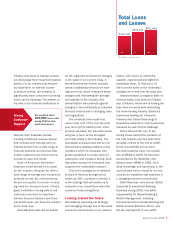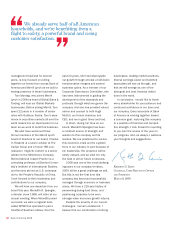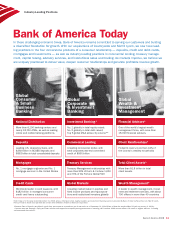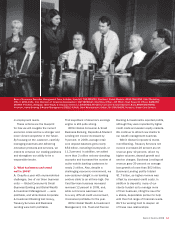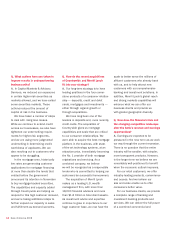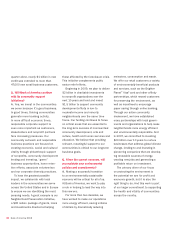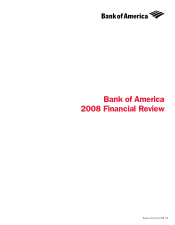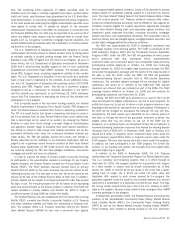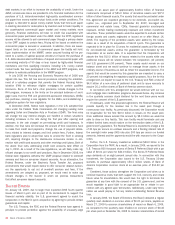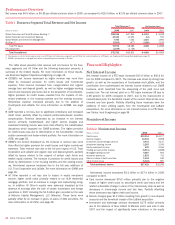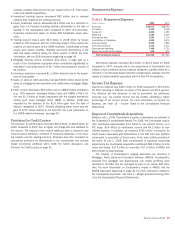Bank of America 2008 Annual Report Download - page 21
Download and view the complete annual report
Please find page 21 of the 2008 Bank of America annual report below. You can navigate through the pages in the report by either clicking on the pages listed below, or by using the keyword search tool below to find specific information within the annual report.Management’ s Discussion and Analysis of Financial
Condition and Results of Operations
Bank of America Corporation and Subsidiaries
This report may contain, and from time to time our management may make,
certain statements that constitute “forward-looking statements” within the
meaning of the Private Securities Litigation Reform Act of 1995. Words such
as “expects,” “anticipates,” “believes,” “estimates” and other similar
expressions or future or conditional verbs such as “will,” “should,” “would”
and “could” are intended to identify such forward-looking statements. These
statements are not historical facts, but instead represent Bank of America
Corporation and its subsidiaries’ (the Corporation) current expectations,
plans or forecasts of the Corporation’s future results, integration plans and
cost savings, future loan modifications, effect of various legal proceedings
discussed in “Litigation and Regulatory Matters” in Note 13 – Commitments
and Contingencies to the Consolidated Financial Statements, growth oppor-
tunities, business outlook, loan and deposit growth, mortgage production,
credit losses, liquidity position and other similar matters. These statements
are not guarantees of future results or performance and involve certain
risks, uncertainties and assumptions that are difficult to predict and often
are beyond the Corporation’s control. Actual outcomes and results may dif-
fer materially from those expressed in, or implied by, the Corporation’s
forward-looking statements. You should not place undue reliance on any
forward-looking statement and should consider all uncertainties and risks
discussed in this report as well as those discussed under Item 1A. “Risk
Factors” of this Annual Report on Form 10-K, as well as those discussed in
any of the Corporation’s other subsequent SEC filings. Forward-looking
statements speak only as of the date they are made, and the Corporation
undertakes no obligation to update any forward-looking statement to reflect
the impact of circumstances or events that arise after the date the forward-
looking statement was made.
In addition to the other risk factors discussed under Item 1A. “Risk
Factors”, possible events or factors that could cause results or perform-
ance to differ materially from those expressed in our forward-looking
statements include the following: negative economic conditions that
adversely affect the general economy, housing prices, the job market,
consumer confidence and spending habits which may affect, among other
things, the credit quality of our loan portfolios (the degree of the impact of
which is dependent upon the duration and severity of these conditions);
the level and volatility of the capital markets, interest rates, currency
values and other market indices which affect among other things the
value of our assets and liabilities and, in turn, our trading and investment
portfolios; changes in consumer, investor and counterparty confidence in,
and the related impact on, financial markets and institutions; the Corpo-
ration’s credit ratings and the credit ratings of our securitizations, which
are important to the Corporation’s liquidity, borrowing costs and trading
revenues; estimates of fair value of certain of the Corporation’s assets
and liabilities, which could change in value significantly from period to
period; legislative and regulatory actions in the United States and interna-
tionally which may increase the Corporation’s costs and adversely affect
the Corporation’s businesses and economic conditions as a whole; the
impact of litigation and regulatory investigations, including costs,
expenses, settlements and judgments; various monetary and fiscal poli-
cies and regulations of the U.S. and non-U.S. governments; changes in
accounting standards, rules and interpretations and the impact on the
Corporation’s financial statements; increased globalization of the finan-
cial services industry and competition with other U.S. and international
financial institutions; the Corporation’s ability to attract new
employees and retain and motivate existing employees; mergers and
acquisitions and their integration into the Corporation, including our ability
to realize the benefits and costs savings from and limit any unexpected
liabilities acquired as a result of the Merrill Lynch acquisition; the Corpo-
ration’s reputation; and decisions to downsize, sell or close units or
otherwise change the business mix of the Corporation.
The Corporation, headquartered in Charlotte, North Carolina operates
in 32 states, the District of Columbia and more than 30 foreign countries
as of December 31, 2008. The Corporation provides a diversified range
of banking and nonbanking financial services and products domestically
and internationally through three business segments: Global Consumer
and Small Business Banking (GCSBB), Global Corporate and Investment
Banking (GCIB), and Global Wealth and Investment Management (GWIM).
At December 31, 2008, the Corporation had $1.8 trillion in assets
and approximately 243,000 full-time equivalent employees. Notes to the
Consolidated Financial Statements referred to in the MD&A are
incorporated by reference into the MD&A. Certain prior period amounts
have been reclassified to conform to current period presentation.
2008 Economic Environment
2008 was a year in which the U.S. economy moved into an economic
recession that deepened late in the fourth quarter, triggered in part by the
intensifying financial crisis. Housing activity and prices declined through-
out the year. Consumer spending softened in the first half of 2008, and
then declined in the second half, weighed down by the spike in energy
prices that reduced real purchasing power, weaker trends in employment,
including underemployment, and personal income and the loss of house-
hold wealth resulting from declines in home prices and stock market
valuations. Sales of automobiles, household durables and consumer
discretionary items were hit the hardest.
In response to the weaker demand, businesses cut production and
employment, and postponed capital spending plans. As a result of the
financial crisis and the economic slowdown, federal government agencies
including the U.S. Treasury Department (U.S. Treasury) and the Federal
Reserve initiated several actions which changed the landscape of the
U.S. financial services industry. For more information related to these
actions, see the Regulatory Initiatives discussion to follow.
The alternative lending facilities provided by the U.S. Treasury, the FDIC
and the Federal Reserve along with aggressive interest rate cuts, failed to
stem the increasing disruptions in the financial markets. In particular, the
tax rebates provided by the Economic Stimulus Act of 2008 gave only a
temporary boost to consumer spending. U.S. export growth, which had
been the strongest sector of the economy in recent years, weakened with
softer global economic conditions. The financial crisis intensified in Sep-
tember 2008 following the collapse of several leading investment banks.
Declines in employment intensified significantly in every month in 2008
and real GDP contracted sharply in the fourth quarter. In addition, mort-
gage, corporate and the related counterparty credit spreads widened and
heightened concerns about the impact of monoline insurers (monolines),
auction rate securities (ARS), structured investment vehicles (SIVs) and
other financial instruments adversely impacted the financial markets.
The deteriorating economy continued to negatively impact the credit
quality of our loan portfolios with more rapid deterioration occurring in the
latter part of 2008. The stress consumers experienced from depreciating
Bank of America 2008
19


